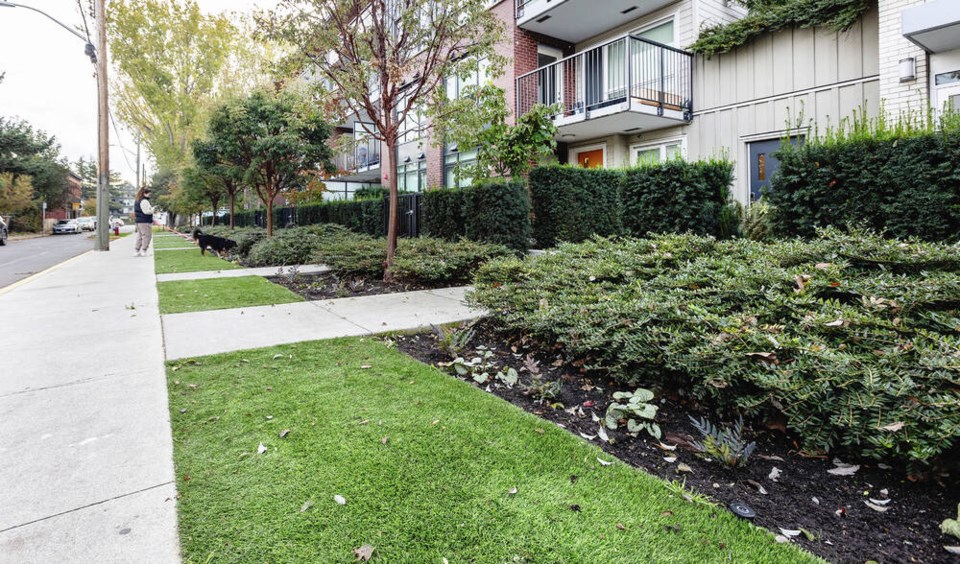It’s finally November, that happy time of year when we can officially relax and stop caring about the front lawn.
The weather is cold, wet and grey for much of the next four to 12 months, leading to a seasonal condition lawn-care professionals call “unemployment.”
There are about a dozen different kinds of grasses that make up most lawns in North America. They fall into two groups: warm-season grasses, which thrive in places like the southern U.S. and the surface of Venus (examples include bermudagrass, St. Augustine and — not making this up — centipedegrass), and cool-season grasses, which do well in the 91ԭ�� Northwest and 91ԭ�� Arctic (Kentucky bluegrass, fescue, marijuana).
Garden experts say it’s important to know your grass type so you can take the best possible care of your lawn. Hahaha, those nutty kidders! That sounds exhausting. This year we’re all going to mow, water, fertilize and curse the suburbs like we always do.
Healthy green real grass requires regular mowing, which in itself requires a mower because, I am told, you can’t just keep borrowing the neighbour’s machine forever.
Also, lawns challenge you with a never-ending parade of invasive weeds to pick, and acres of moss to depress you throughout the winter. Finally, real grass requires bags of fertilizer with phosphates and micro-nutrients, which, if I am being honest, just means very, very small nutrients.
If your home was built at some point in the last 150 years, it probably came with a lawn and a hot-water tank and bathroom-tile grout and a whole bunch of stuff you may not be interested in pouring money and time into for the rest of your life.
Let’s say you’re a dirty hippie on Salt Spring Island and your basic approach to home ownership is along the lines of: “Like, what are property values really, man?” You may be ready to give up and embrace the No-Mow Movement.
No-mow yards fall into four categories:
1. Un-mowed turf grass left to do its thing, which is: harbour ticks and dog poo, reduce street appeal and give the neighbours something to yell about.
2. Low-grow turf grass that does all of the above, only it takes a couple of seasons before it really looks its worst and passersby just assume the owner died in the crawlspace months ago.
3. Native or naturalized landscapes where turf grass is replaced with non-invasive, climate-friendly plants that give you smug bragging rights but take up 4,000% of your time.
4. Cars and trucks on blocks. If you collect enough of them, you can shade out everything except for raccoons and alt-right conservatives attracted by the esthetics of rust and hydrocarbons leaking into groundwater.
Sports fans will already be familiar with another grassless lawn option: Astroturf, the short-pile synthetic turf invented in 1965 by Monsanto, the very same company that brought us Agent Orange, DDT and other dangerous chemicals that for sure give you cancer. On the other hand: sports!
Today, most “ChemGrass” (the original patent name for Astroturf — I swear I am not making this up) looks realistic, especially at night during severe windstorms with widespread power outages.
Drive around Langford for examples of this artificial grass along the boulevards. Do this safely, i.e. do not roll down your window, and do not make eye contact with locals, obviously.
The main advantage of artificial grass is that it does not need much maintenance. Over its 20-year lifespan, it never needs to be mowed, fertilized or watered, saving you about 250 litres of increasingly expensive water every year.
In the Capital Regional District, it’s just about cheaper to water your lawn with 1990 Dom Perignon Brut than actual water. Artificial grass is also an excellent choice for seasonal allergy sufferers, unless you are allergic to fake green plastic or 1990 Dom Perignon Brut.
The main disadvantage of a fake lawn is that it identifies the homeowner as a crazy person: “There’s Steve, out vacuuming his grass again. What a weirdo.” I should mention that artificial turf requires regular vacuuming to maintain a debris-free surface. It also requires periodic cleaning with soapy water and a special broom.
Because Astroturf is made from oil — the same as shampoo bottles and sandwich baggies — your fake lawn will eventually end up in a landfill forever and ever and ever.
And finally, even higher-quality artificial lawns look pretty cheap and crappy, like you picked the worst carpet in the history of floor covering, then decided to put it outside and hope dogs stay away. (They don’t.)
I will always be a real lawn guy, and for a reason we haven’t yet touched upon: the gentle drone of a mower and the smell of freshly cut grass transport me across time and space:
Oh, the moonlight’s fair tonight along the Wabash
From the fields there comes the breath of new mown hay
Through the sycamore the candle lights are gleaming
On the banks of the Wabash, far away
I am 10 years old, and already it is my job to take care of the family yard in smalltown southern Alberta. My father shows me what to do: this year we’re going to mow, water, fertilize and curse the suburbs like we always do.



